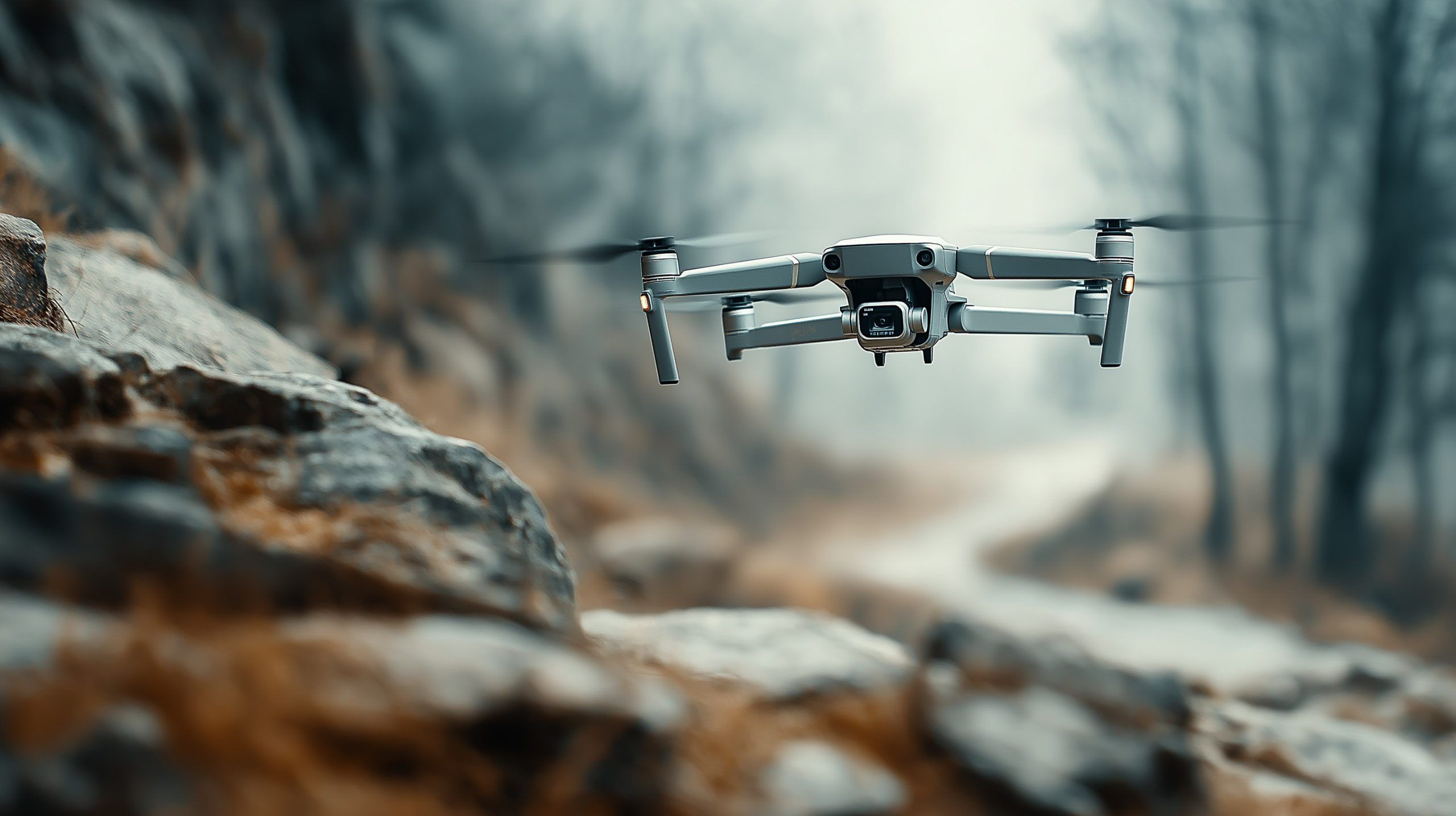- In 2025 Beijing imposed sweeping new limits on drone exports, halting or sharply reducing sales to Ukraine, the United States, and Europe while shipments to Russia appear to continue.
- Ukrainian President Volodymyr Zelensky said that “Chinese Mavic is open for Russians but is closed for Ukrainians,” referencing DJI’s Mavic drones used in the war.
- On September 1, 2024, China’s export controls took effect, banning exports of all unregulated civilian drones that could serve military uses and adding high-end infrared imaging gear, laser rangefinders, and precision inertial navigation units to the export-control list.
- Under the new rules, exports of drone parts such as batteries, motors, magnets, flight controllers, cameras, and radio modules to Western markets were restricted and shipments blocked by air or sea.
- Russia continued to obtain Chinese drones and components, including via direct shipments, third-party intermediaries, or local joint ventures, despite the export restrictions.
- NATO labeled China a “decisive enabler” of Russia’s war effort due to Chinese drone technology support.
- In April 2025, China’s Commerce Ministry placed 11 U.S. drone companies—including Skydio and BRINC—on an “unreliable entities” blacklist, barring exports or investment over alleged military-technology cooperation with Taiwan.
- China’s 2020 Export Control Law provides the legal basis to restrict exports of sensitive dual-use drone tech, with enforcement challenged by smuggling and re-export via third countries.
- DJI, the world’s largest drone maker commanding about 80% of the global consumer drone market and roughly 90% of the U.S. market for commercial drones, suspended sales in Ukraine and Russia in April 2022 and faced U.S. Customs detention of shipments from October 2024 under the Uyghur Forced Labor Prevention Act, contributing to delays of the Mavic 4 Pro in the U.S.
- The policy has spurred Ukraine to mass-produce drones domestically under the Army of Drones initiative, while Western firms pursue non-Chinese supply chains and “China-free” drones, signaling a potential East–West bifurcation in the global drone market.
China’s New Drone “Iron Curtain” on Drones
In 2025, Beijing imposed sweeping new limits on drone exports, sending shockwaves through battlefields and markets worldwide. Chinese authorities have halted or sharply reduced drone sales to Ukraine, the U.S., and Europe, even as flows to Russia appear to continue unabated [1] [2]. Ukrainian President Volodymyr Zelensky has publicly blasted this policy, noting that “Chinese Mavic is open for Russians but is closed for Ukrainians” [3] – a reference to DJI’s popular Mavic quadcopter drones that both sides in the Ukraine war have repurposed for combat. Zelensky even alleged Chinese personnel are present on drone production lines in Russia, effectively helping Moscow build drones locally despite the export bans [4].
Beijing denies arming either side in the Russia–Ukraine conflict. China’s Foreign Ministry insists it “has never provided any side with lethal weapons and strictly controls dual-use items” like drones [5]. Officially, China says the new export controls are meant to prevent drones being used for “non-peaceful purposes” or terrorism [6]. In late 2024, China’s Commerce Ministry announced it would ban exports of all unregulated civilian drones that could serve military uses, and add critical drone technologies – high-end infrared imaging gear, laser rangefinders, and precision inertial navigation units – to its export control list [7]. These regulations took effect on September 1, 2024, setting the stage for the tightened regime seen in 2025 [8].
Under the new rules, even certain drone features and components are restricted. Chinese companies curtailed exports of key parts like batteries, motors, magnets, flight controllers, cameras, and radio modules to Western markets [9] [10]. Shipping firms in China were ordered to stop delivering a long list of drone-related items by air or sea parcel, from quadcopter motors and gimbal cameras to radio transceivers and even hunting optics [11] [12]. These measures were ostensibly applied globally (Chinese officials said the expanded controls “do not target any specific country or region” [13]) – including Russia on paper – but in practice a stark East-West divide has emerged. Chinese regulators have largely choked off drone supplies to Ukraine and NATO countries, while Russian buyers continue to obtain Chinese drones and parts, whether through direct shipments, third-party intermediaries, or local joint ventures [14] [15]. Western governments have taken note: NATO now labels China a “decisive enabler” of Russia’s war effort due to such technology support [16].
Geopolitical Motives: Why Is Beijing Clamping Down?
Several political and strategic factors drove China’s drone export crackdown. Beijing is walking a tightrope in the Ukraine war. It proclaims neutrality, yet Western officials frequently cite evidence of Chinese drones and electronics bolstering Russia’s military [17] [18]. With pressure mounting – and U.S. intelligence reporting surging Chinese drone sales to Russia and even joint drone factories on Russian soil [19] – China moved to tighten export controls to deflect Western criticism. The Commerce Ministry explicitly linked the new restrictions to stopping drones from fueling conflict, even invoking the prevention of WMD proliferation as a justification [20] [21].
At the same time, China’s actions are part of an ongoing tech tussle with the West. In recent years, Washington has targeted Chinese tech companies (including drone makers) with sanctions, citing security and human rights concerns [22] [23]. In response, Beijing is leveraging its dominant position in drone manufacturing as a trade war tool. Notably, in April 2025 China’s Ministry of Commerce put 11 U.S. drone companies – including prominent firms like Skydio and BRINC – on an “unreliable entities” blacklist, barring them from Chinese exports or investment [24]. Beijing accused these companies of “military technology cooperation with Taiwan,” a move widely seen as retaliation for U.S. support of Taiwan and earlier American sanctions [25] [26]. The blacklist means Chinese suppliers can no longer ship components to those U.S. firms, underscoring that drones have become a flashpoint in the U.S.–China trade conflict [27] [28].
Economic security and national defense considerations also underlie China’s policy. Drones are a dual-use technology: the same quadcopter sold for filming or farming can be converted into a battlefield asset. By tightening export approvals, Beijing aims to maintain control over advanced drone tech and ensure it isn’t turned against China or its allies. Chinese officials have voiced concern about drone-aided warfare, likely eyeing how inexpensive UAVs can threaten even major powers. Domestically, China’s 2020 Export Control Law provides a legal basis to restrict exports of sensitive tech in the name of national security – and drones are now squarely in that category [29]. Moreover, these export limits send a signal amid broader tit-for-tat measures. Shortly before China’s drone clampdown, the U.S. imposed new bans on selling advanced chips and semiconductor tools to China [30]. Beijing’s response – from drone parts curbs to a halt on rare earth mineral exports – is calibrated to hit Western supply chains where it hurts, without overtly escalating into a full embargo [31] [32].
Timeline of Tightening Controls (2023–2025)
China’s drone export policy didn’t shift overnight – it evolved over several key inflection points in 2023–2025, as global conflicts and trade disputes intensified:
- April 2022: Even before official export bans, leading manufacturer DJI voluntarily suspended all business in Russia and Ukraine to prevent its drones’ use in combat [33] [34]. This unprecedented move by a Chinese firm came as Ukrainian officials accused DJI of aiding Russian targeting (charges DJI called “utterly false”) [35]. DJI stated it “abhors any use of our drones to cause harm” [36], trying to stay neutral in the war.
- July 2023: Facing reports of Chinese drones on Ukrainian battlefields, China’s government imposed temporary export controls on certain drones. It banned exports of “long-range” civilian drones over 7 kg that could carry heavy payloads [37]. It also forbade exporting any civilian drone for military purposes, laying a two-year foundation for tighter oversight [38] [39].
- Sept 1, 2023: China’s initial drone export regulations took effect. Alongside drones, specific components and tech were restricted – e.g. high-end imaging, night-vision and laser targeting equipment required a license [40] [41]. Beijing framed this as preventing misuse in Ukraine’s war. (Chinese media at the time decried Western “smears” that China was arming Russia [42].)
- Mid-2024 Adjustments: In a surprising tweak, China announced it would lift some temporary curbs on low-end consumer drones to “safeguard global supply chains,” effective September 2024 [43] [44]. DJI welcomed this loosening, saying it would “be favorable for the development of the drone industry” [45]. However, at the same time Beijing strengthened controls on high-tech components, adding items like precision measurement units to the control list [46] [47]. China also quietly began blocking small parcel shipments of many drone parts to Ukraine and Russia to tighten enforcement [48] [49].
- Late 2024: Evidence mounted that China’s curbs were hindering Ukraine. By December 2024, Ukraine was scrambling to “China-proof” its drone supply chain as Chinese-made batteries and motors dried up [50] [51]. Chinese firms reportedly halted sales of critical parts like flight controllers and imaging sensors to Ukraine, the U.S., and EU, anticipating even broader bans in 2025 [52] [53]. During a visit to Beijing, China assured Ukraine’s foreign minister that it “had not sent weapons to Russia and would not do so,” emphasizing instead that it was tightening drone export checks to all sides [54].
- Early 2025: As feared, China’s stricter policies kicked in fully. Western drone makers and militaries felt the squeeze. Ukraine, which had sourced an estimated 60% of DJI’s global Mavic drone output in 2023 for its defense [55] [56], suddenly saw that pipeline cut off. Reports emerged of Chinese suppliers outright reducing or refusing orders from Western customers for drone batteries, magnetics, and other components [57] [58]. Meanwhile, Russia appeared to ramp up its own drone production with Chinese help: by 2024, Russia produced hundreds of thousands of drones (often using Chinese electronics) and hosted Chinese-linked assembly lines on its territory [59] [60].
- April 2025: The drone export spat became entwined with the wider US–China trade war. After the U.S. hit China with new tariffs and export blacklists, Beijing responded by sanctioning American drone companies and cutting off exports of drone batteries to U.S. firms deemed unfriendly [61] [62]. One high-profile casualty was Skydio, a leading U.S. drone maker: China’s sanctions on Skydio’s suppliers forced it to ration batteries and scramble for non-Chinese parts [63] [64].
- May 2025: The issue exploded into headlines when President Zelensky, during a European tour, accused China of deliberately favoring Russia. He stated that Chinese drones and parts had effectively “stopped” for Kyiv and the West, but not for Moscow [65] [66]. A European official backed this, telling Bloomberg that China was indeed “curtailing deliveries” of drone motors and electronics to Western buyers while “ramping up supplies to Russia” [67] [68]. China’s Foreign Ministry angrily rejected the claim, repeating that it “never provided lethal aid” and urging peace talks [69] [70]. But Western countries took Zelensky’s warning seriously as Russia kept deploying swarms of mostly Chinese-made drones on the battlefield.
Civilian vs. Military Drones: A Blurry Line
China’s restrictions cover both civilian hobbyist drones and military-grade UAVs, reflecting the increasingly blurry line between the two. DJI’s Phantom and Mavic drones, for instance, were designed for aerial photography – but on Ukraine’s front lines they’ve been modified to drop grenades or act as spotters for artillery [71] [72]. These are ostensibly “civilian” products being put to lethal use, making them a prime target for export controls as “dual-use” items. Beijing’s new rules explicitly ban exporting any “unregulated” civilian drone that could be used for military purposes or terrorism [73]. In practice, that casts a wide net: from high-end prosumer drones with long flight ranges, to agricultural drones that can carry heavy payloads, to mapping drones equipped with infrared cameras – all could be repurposed in conflict and thus now require special export licenses [74] [75].
On the purely military side, China has long been a major player in armed drone sales. It ranks as the world’s #4 weapons exporter, and its state-owned manufacturers have sold large combat drones (like the Wing Loong and CH-series UAVs) to countries in Asia, Africa, and the Middle East [76] [77]. Those military-specific drone exports were always tightly regulated (and often politically negotiated). Notably, China has not supplied such heavy combat drones to Russia or Ukraine, likely to avoid direct entanglement in the war. Instead, it is the commercial drone supply chain – the chips, cameras, batteries, and $1,000 quadcopters from companies like DJI, Autel, and others – that became a shadow arms pipeline to combatants. By clamping down on civilian drones and key parts, China is effectively asserting that it will police how its high-tech exports are used abroad. Officially, Chinese law now forbids even indirect export of civilian drones for military ends [78], and authorities have pledged to punish Chinese companies that knowingly aid drone deployments in warzones.
However, enforcing this is challenging. Many Chinese drone components are generic and widespread, so smuggling and re-export are hard to prevent. For example, Chinese-made drone parts can be routed through third countries. Reports indicate Russian importers have used intermediaries in the Middle East and Asia to keep buying DJI drones despite sanctions. And while China insists its export rules apply equally to Russia, it has less incentive to aggressively stop border trade with its strategic partner. Indeed, Russian customs data and wreckage from downed drones in Ukraine show a heavy prevalence of Chinese electronics – from navigation chips to servo motors – continuing into 2024–25 [79] [80]. This dual-use dilemma highlights why China’s export crackdown is so controversial: the same technology that powers a child’s toy drone can guide a bomb in wartime. Beijing’s new export controls attempt to draw a line, but as modern conflicts have shown, almost any advanced civilian tech (phones, drones, vehicles) can be repurposed on the battlefield.
DJI: The Drone Giant Caught in the Middle
No company personifies this saga more than DJI, the Shenzhen-based drone colossus at the center of U.S.–China tech tensions. DJI is the world’s largest drone maker by far – commanding roughly 80% of the global consumer drone market and an estimated 90% of the U.S. market for commercial drones [81] [82]. Its bestselling Phantom, Mavic, and Inspire drones have become nearly synonymous with modern drones. This dominance means any Chinese export restriction is effectively a restriction on DJI’s products. Indeed, industry analysts warned that if China cut off DJI and its peers, it could “reshape global supply chains” and leave a massive gap for others to fill [83].
DJI has tried to navigate the geopolitical storm carefully. The company publicly stresses that it is purely focused on civilian uses – not defense. “We have never designed, developed or manufactured military-grade equipment… nor marketed or sold our products for combat use in any country,” DJI affirmed in mid-2024 [84] [85]. It swiftly complied with China’s export regulations; DJI said it “will continue to strictly comply with and implement China’s export control rules” [86]. When Beijing loosened some rules on consumer models in 2024, DJI applauded the move as helping the industry [87]. And when the rules tightened, DJI toed the line – even if it meant losing short-term sales. In April 2022, DJI took the dramatic step of suspending all sales in both Ukraine and Russia on its own accord, declaring it abhorred its drones being used in combat [88] [89]. That earned it some goodwill internationally, but also backlash from pro-Russia voices in China. It shows how DJI has been walking a fine line: trying to remain a global commercial brand while not angering Chinese authorities or nationalists.
Despite its neutral stance, DJI has been squeezed by foreign governments. The U.S. government, in particular, has taken an increasingly hard line against DJI, citing security fears that DJI drones could spy for Beijing or that its supply chain relies on forced labor. DJI was added to the U.S. Commerce Department’s Entity List (export blacklist) in 2020, limiting its access to some American tech, over allegations it aided surveillance of Uyghur Muslims [90]. In 2021, the U.S. Treasury put DJI on an investment blacklist, and the Pentagon labeled it a “Chinese military company” (a designation DJI is fiercely litigating in court) [91] [92]. Congress has also pushed to ban DJI outright: a pending bill would add DJI to the FCC’s “Covered List,” effectively outlawing its drones from U.S. communications infrastructure and federal procurement [93] [94]. DJI has hit back at these efforts as “baseless allegations and xenophobic fear” [95] [96], noting that multiple U.S. security audits since 2017 found no major data leaks in its products [97]. Nevertheless, if a mandated federal security review isn’t completed by the end of 2025, DJI faces an automatic ban from U.S. markets under the latest National Defense Authorization Act [98].
In 2025, DJI’s troubles mounted as U.S. Customs began blocking its shipments. Since October 2024, American ports have detained large batches of DJI drones under the Uyghur Forced Labor Prevention Act (UFLPA), which bars products made with any Xinjiang-sourced inputs [99]. DJI vehemently denies using forced labor, pointing out its manufacturing is in Shenzhen and outside China (e.g. DJI opened a drone assembly plant in California and another in Shenzhen’s tax-free zone) [100]. Still, the Customs holdup has effectively choked DJI’s supply in the U.S. – by mid-2025, DJI’s online store showed most models “sold out,” and big retailers like Best Buy and Amazon ran critically low on DJI stock [101]. Even the launch of DJI’s newest flagship drone, the Mavic 4 Pro, was stalled in the U.S. due to customs uncertainty [102]. DJI insists this is a “misunderstanding” rather than a ban [103], and has provided extensive documentation to CBP to prove its compliance [104]. Yet, as of mid-2025, many American drone pilots have been unable to buy new DJI drones, illustrating how export restrictions (from both China and the West) are isolating DJI from key markets. The company’s future now hangs on geopolitical developments: easing tensions could reopen skies for DJI, while a continued tech Cold War could see the world’s top drone maker increasingly shut out of Western skies.
Global Fallout and Reactions
China’s 2025 drone export restrictions are reverberating across continents, prompting responses from governments, industries, and the public. In Ukraine, the impact is stark. Drones have become lifesaving eyes in the sky for Ukraine’s military, which was losing up to an estimated 10,000 drones per month in intense combat [105]. The sudden squeeze on Chinese supplies threatens to ground some of those eyes. Ukraine’s government has scrambled to react: President Zelensky in April 2025 announced a crash program to mass-produce drones domestically “to the maximum” capacity [106]. Ukrainian startups and state factories are now building everything from small FPV kamikaze drones to long-range surveillance UAVs. Kyiv also launched a public “Army of Drones” campaign to crowdfund and source drones from friendly nations. But officials admit a key bottleneck is critical components – chips, batteries, motors – much of which used to come cheaply from China. Now, workarounds are needed. Ukrainian manufacturers have resorted to using European intermediaries to import Chinese parts (driving up costs) [107], and even cannibalizing electronics from appliances to keep drone production going (a desperate tactic Russia also used when sanctioned) [108]. There is talk in Kyiv of sanctioning Chinese firms that arm Russia [109], but Ukraine is wary; it doesn’t want to provoke Beijing into even tighter restrictions or diplomatic backlash.
Western governments and alliances have generally lined up in support of Ukraine and against China’s export stance. The European Union and U.S. have both sanctioned Chinese companies caught funneling drone technology to Russia [110]. In fact, throughout 2023–2024, the EU incrementally added several Chinese tech firms to its Russia sanctions list for “providing drone components” to Moscow. In early 2025, EU officials signaled a new package of measures to block third-country circumvention, specifically naming Chinese electronics firms that were found re-exporting chips and optics to Russia’s drone programs [111]. NATO’s leaders have bluntly warned China to stop aiding Russia’s aggression, with one report calling Beijing’s tech support a “decisive enabler” for the Russian military machine [112]. In Washington, lawmakers cite China’s drone embargo as further proof that the West must decouple from Chinese supply chains. As one U.S. drone executive put it, “the Chinese government will use supply chains as a weapon to advance their interests over ours” [113]. Western defense ministries are investing in home-grown drone projects and “Blue UAS” alliances to certify non-Chinese drones for government use. Japan, for instance, banned government purchase of DJI drones in 2020 and has funded domestic drone makers, anticipating exactly the kind of supply cutoff now occurring.
For the global drone industry, China’s clampdown is a double-edged sword. In the short term, it’s disruptive: Chinese-made drones and parts became scarce in Western markets, causing price spikes and project delays. Many commercial drone operators in the U.S. and Europe, from real estate photographers to infrastructure inspectors, rely on affordable DJI models. By mid-2025, some report having to delay jobs or pay steep markups to obtain drones due to the shortages [114]. Enterprise drone programs (like those in public safety or agriculture) are evaluating non-Chinese alternatives, but switching comes with compatibility issues and higher costs. On the other hand, the shake-up presents an opportunity for non-Chinese manufacturers. Companies in the U.S., Europe, Israel, and Japan are racing to fill the gap with “China-free” drones [115]. Governments are pumping money into these players to boost production. If they can scale up, the dominance of Chinese drones might finally be challenged. Indeed, China’s restrictions might “strengthen DJI’s dominance” in the near term by undercutting its Western rivals’ supply lines [116], but over the longer term they risk splitting the global drone market. We may see a bifurcation: one ecosystem of drones built with Chinese components for friendly markets, and another of Western-sourced drones for the U.S., EU, and allies [117] [118]. This fragmentation could hinder interoperability and drive up costs for all.
Public reaction to China’s drone export moves has been mixed. In China, nationalist commentators approve of using tech exports as leverage against the West, especially after years of U.S. sanctions on Chinese companies. However, Chinese drone manufacturers (DJI included) worry that over-strict controls could damage their global reputation and revenues, since foreign buyers might opt to avoid Chinese products altogether. In the West, many lawmakers welcomed steps that might curb Russia’s drone resupply, but they remain skeptical of China’s true intent. Analysts note that Russia still appears to be getting what it needs – evidenced by the continuing barrage of Shahed and Mavic drones over Ukraine – so they doubt China’s neutrality claims [119]. Meanwhile, Western drone hobbyists and professionals voice frustration on forums about being caught in a geopolitical crossfire; as one drone pilot lamented, “Politics grounded my drone”. Yet there is also a growing awareness that the era of easy global tech trade is ending. As a tech YouTuber covering the issue noted, “We’re seeing an Iron Curtain descend on the drone world – one that might force everyone to pick a side.”
Looking Ahead: Drones at the Crossroads of Tech and Geopolitics
China’s 2025 drone export limitations underscore how technology is now tightly interwoven with geopolitics. Drones – once niche gadgets – have proven their worth on the modern battlefield, in espionage, and in commerce, making them strategic assets countries fight over. Moving forward, several trends seem likely:
- Continued Decoupling: Unless there’s a thaw in great-power relations, China and the West will keep unwinding their drone supply interdependence. China will prefer to supply drones to friendly or non-aligned nations, and restrict sales to adversaries. Western countries, in turn, will invest in domestic drone tech and impose more bans on Chinese drones in sensitive uses. This could lead to two parallel drone industries divided by an East-West tech gulf [120] [121].
- Innovation under Pressure: Ukraine’s predicament has spurred impressive innovation – from 3D-printed drone components to open-source drone software – as it seeks to replace Chinese inputs. Likewise, Western firms like Skydio are accelerating efforts to build all-American supply chains after China’s sanctions [122] [123]. In China, manufacturers may double down on advanced drone R&D (swarming AI, higher endurance) to maintain an edge even if they lose some foreign markets.
- Political Bargaining Chip: Drones will remain a bargaining chip in diplomacy. China could relax export curbs as part of a broader deal (for example, if the U.S. eases certain tariffs or sanctions) to show goodwill. Conversely, it could tighten them further if tensions spike – for instance, if Western nations send higher-grade weapons to Taiwan or if conflict erupts in the South China Sea. The trajectory of China’s drone policy will thus mirror the overall state of its foreign relations.
- Battlefield Impact: In the near term, Ukraine and Russia’s drone war will be a litmus test of China’s restrictions. If Russia manages to significantly scale up drone production with Chinese help despite the “ban,” it will suggest loopholes that need closing. If Ukraine manages to diversify away from Chinese parts (with Western help) and sustain its drone fleet, it lessens Beijing’s leverage. Other countries are watching closely – from Middle East battlefields to East Asian flashpoints, combatants are factoring in: Can we count on Chinese drones? Or do we need Plan B?
- International Norms?: The situation also raises the question of global norms for drone exports. Just as there are treaties on arms exports, some experts call for agreements on robotic systems. China’s stated concern about civilian drones being used violently is valid – and not just in Ukraine; militants and terrorists worldwide have weaponized hobby drones. There may be efforts in the UN or other bodies to set standards (for example, embedding no-combat-use clauses in sale contracts, or technical locks on certain features). However, enforcement would be difficult, and major powers may prefer unilateral control.
In conclusion, the drone has become much more than a flying camera – it’s now symbolic of the broader tech struggle between China and the West. China’s export limitations in 2025 have redrawn the map of who can access drone technology, especially tipping the scales on a European battlefield. As one Bloomberg analyst put it, “Ukraine might have to China-proof its supply chain for drones” in the face of expected bans [124]. The world is learning that dominance in a critical tech sector (like China’s 80% share of drones [125]) can be turned into geopolitical leverage overnight. For the public, this saga is a wake-up call that even consumer devices are not immune to international politics. For governments and companies, it’s a lesson in the fragility of globalized supply chains [126] [127]. And for soldiers on the ground, it’s literally life and death – when the drones above suddenly fall silent or disappear from the shelves, the consequences are very real. The year 2025 may be remembered as a turning point when the free flow of drones was clipped by geopolitical winds, changing how the world sees the skies above.
Sources: China’s Ministry of Commerce via Reuters and AP News [128] [129]; Bloomberg and Kyiv Independent reports [130] [131]; DroneXL and DroneLife industry analyses [132] [133]; CSIS and NATO assessments [134] [135]; DJI and U.S. government statements [136] [137]; U.S. Customs enforcement updates [138]; Reuters news on DJI’s 2022 actions [139].
References
1. kyivindependent.com, 2. dronexl.co, 3. kyivindependent.com, 4. kyivindependent.com, 5. dronexl.co, 6. apnews.com, 7. apnews.com, 8. apnews.com, 9. dronelife.com, 10. kyivindependent.com, 11. www.kyivpost.com, 12. www.kyivpost.com, 13. www.reuters.com, 14. kyivindependent.com, 15. www.kyivpost.com, 16. kyivindependent.com, 17. kyivindependent.com, 18. apnews.com, 19. apnews.com, 20. apnews.com, 21. apnews.com, 22. dronedj.com, 23. www.dji.com, 24. dronedj.com, 25. dronedj.com, 26. dronexl.co, 27. dronexl.co, 28. dronexl.co, 29. apnews.com, 30. dronelife.com, 31. dronexl.co, 32. dronexl.co, 33. www.reuters.com, 34. www.reuters.com, 35. www.reuters.com, 36. www.reuters.com, 37. www.csis.org, 38. www.reuters.com, 39. www.reuters.com, 40. apnews.com, 41. apnews.com, 42. www.reuters.com, 43. www.reuters.com, 44. www.reuters.com, 45. www.reuters.com, 46. www.reuters.com, 47. www.reuters.com, 48. www.kyivpost.com, 49. www.kyivpost.com, 50. dronelife.com, 51. dronelife.com, 52. dronelife.com, 53. dronelife.com, 54. www.reuters.com, 55. www.csis.org, 56. www.csis.org, 57. dronelife.com, 58. dronexl.co, 59. dronelife.com, 60. kyivindependent.com, 61. dronedj.com, 62. dronedj.com, 63. dronedj.com, 64. dronedj.com, 65. kyivindependent.com, 66. kyivindependent.com, 67. dronexl.co, 68. kyivindependent.com, 69. dronexl.co, 70. kyivindependent.com, 71. dronexl.co, 72. dronexl.co, 73. apnews.com, 74. apnews.com, 75. apnews.com, 76. apnews.com, 77. apnews.com, 78. www.reuters.com, 79. kyivindependent.com, 80. kyivindependent.com, 81. www.csis.org, 82. www.csis.org, 83. dronelife.com, 84. www.reuters.com, 85. www.reuters.com, 86. www.voanews.com, 87. www.reuters.com, 88. www.reuters.com, 89. www.reuters.com, 90. www.dji.com, 91. dronedj.com, 92. dronedj.com, 93. www.dji.com, 94. www.dji.com, 95. www.dji.com, 96. www.dji.com, 97. www.dji.com, 98. dronedj.com, 99. dronedj.com, 100. dronedj.com, 101. dronedj.com, 102. dronedj.com, 103. dronedj.com, 104. dronedj.com, 105. www.csis.org, 106. kyivindependent.com, 107. www.csis.org, 108. www.csis.org, 109. kyivindependent.com, 110. dronexl.co, 111. dronexl.co, 112. kyivindependent.com, 113. dronedj.com, 114. dronexl.co, 115. dronelife.com, 116. dronexl.co, 117. dronexl.co, 118. dronexl.co, 119. kyivindependent.com, 120. dronexl.co, 121. dronexl.co, 122. dronedj.com, 123. dronedj.com, 124. dronelife.com, 125. dronelife.com, 126. dronexl.co, 127. dronexl.co, 128. apnews.com, 129. www.reuters.com, 130. kyivindependent.com, 131. kyivindependent.com, 132. dronexl.co, 133. dronelife.com, 134. www.csis.org, 135. kyivindependent.com, 136. www.reuters.com, 137. dronedj.com, 138. dronedj.com, 139. www.reuters.com









